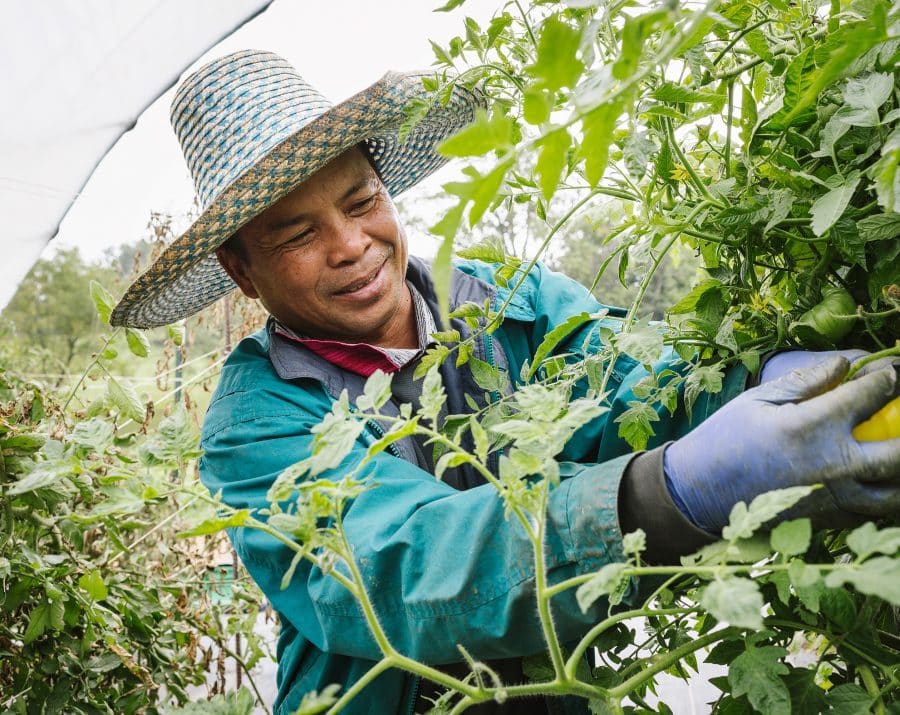At Red Tomato we put farmers first. As food systems become increasingly consolidated, we work to ensure growers in our region have a place in the global market. Yet, as a food hub, moving produce is just part of what we do.
Our position in the supply chain allows us to act as a translator. We speak daily with both our farmers and customers to learn about their needs. What are their customers asking for? What has this morning’s rain done to the crop?
From our position as a food hub, we create and connect solutions to build a fairer, healthier, more sustainable food system!
Food Hub Logistics
The global supply chain has no room for 'small'-scale supply.Our food hub is continuously working to develop supply chains that work for our growers, customers — and you!
Global supply chains rely on large loads of a single product: Containers of bananas shipped north, truckloads of apples driven across the country, mangos flown around the world. These products are grown, packed, and shipped from a few high-volume locations. It’s cheap and relatively efficient to manage.
But it often means that produce is picked before it’s ready, ripened on a truck as opposed to in the field. It also means the same standard varieties are sold everywhere. The people behind the product become invisible as soon as the shipment leaves the farm. Produce delivered regionally can be picked closer to its peak and connected to the source. It’s fresher, and we think tastes better!
Our food hub works around the clock to coordinate product from many different farms and deliver it to our customers’ individual stores or warehouses in as cost-effective a manner as possible. Here are some examples of those efforts:
- In 2002 we canceled our trucking and warehouse leases and sold our produce coolers. We were duplicating efforts – there had to be a better way!
- In 2003 we launched our direct-to-warehouse distribution channel. We coordinated shipments of apples, peaches, and vegetables from a few farms, and paid a trucking company or farmer to make the delivery for us.
- In 2014 we launched our direct-store-delivery program. After taking orders from individual stores, our team sources, aggregates, and coordinates trucking for products heading to locations throughout the Northeast.
Market Development
Getting produce to the grocery store is only one part of the work of our food hub.To truly build a market for local food, we need to develop regional supply.
What happens when a grocery store wants Northeast tomatoes for four months in a row? Or orchards begin growing table grapes to diversify their farm for the next generation?
If it’s grown in our region, grocery stores should source here first. But what happens when the grocery store wants local tomatoes four months of the year, and your farmer in Massachusetts only has them for two? A regional supply chain can extend the local season for everyone. Our food hub develops partnerships with growers across the region, from Maine and Vermont to Pennsylvania and New Jersey. By partnering with growers throughout our region, we can meet the needs of the grocery store and build a continuous supply across the region! By sourcing from the region, we can bring multiple farmers to the table, where, by themselves, they may not have had the supply to meet customer demand.
Market development also means building demand and supply for new and diverse crops. In 2015 one of our farm partners had their first varieties of local table grapes ready. Our team set out to educate consumers and produce buyers about these unique fruits. Local grapes taste different. One variety turns brown when it has the most sugar and flavor – not when it’s going bad. Everyone is used to California grapes – we continue to bring all parties to the table to discuss all aspects of the process and find new buyers.
Differentiating Regional Supply
Packaging and marketing are powerful ways to tell the farm and product story.Creating packaging and building marketing programs that work for a diverse network of farmers isn’t cheap. Our creative team that helps design signage, packaging, and digital marketing to expand impact and reduce costs for our grower network. This is just another way our unique food hub operates.
A short, sweet story, well-designed graphics, and clear information help make a strong connection to the farm. More and more fresh produce is sold in some type of bag, tray, or other packaging. The information on the package is the only message that stays with the produce all the way from the farm to the consumer’s kitchen. By using packaging to reinforce what Red Tomato stands for, we hope to make the products more valuable (and recognizable) to growers and customers.
We develop signage and display material around farm stories and images that can be customized for growers, stores, and institutions. We build digital resources and campaigns to raise awareness of programs and farms. Coordinated marketing through Red Tomato brings resources to support the costs of design and production. Most importantly, it reinforces a strong, consistent message that ties our network together and helps eaters understand and appreciate the value of these farmers and regional agriculture.
Moving the Movement
Collaboration strengthens the local food movement.Writing, speaking, meeting, and learning. Presentations, partnerships with local organizations, consulting projects, blog posts, and national keynote addresses are some of the many ways we are committed to sharing our work as a food hub!
A farmer-focused, place-based, ecological, fair trade food system is the way to a better world. It’s part of why we’re a non-profit.
As an organization we believe in continuous improvement, an ethos most farmers embody as well. When we experience success (or failure!) we share that with the good food movement in our work to build cross-movement collaborations.






